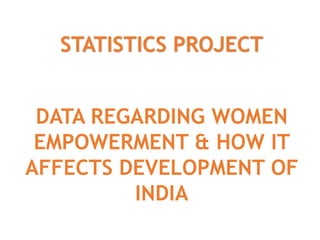
women empowerment
- 1. STATISTICS PROJECT DATA REGARDING WOMEN EMPOWERMENT & HOW IT AFFECTS DEVELOPMENT OF INDIA
- 2. It is the process, and the outcome of the process, by which women challenge gender-based discrimination against women/men in all the institutions and structures of society.
- 3. IMPROVES IN PERSONAL KNOWLEDGE SELF – DEFINING POWER PERSONAL POWER AUTHENTICITY PHYSICAL STRENGTH & EQUALITY MUTUALITY IN RELATIONSHIPS ECONOMIC INDEPENDENCE WOMEN IDENTIFICATION FREEDOM FROM OPPRESSION HAVING POLITICAL POWER IN SOCIETY
- 4. INDICATORS MALE FEMALE % of unorganised workers in total work force 90.7 95.9 % of unorganised sector workers in total work force 84 91.3 % of workers in agriculture and allied activities 48.9 72.8 Time spent on care and household maintenance per week 4 hours 35 hours % of unorganised non- agriculture workers, working from own home 15.7 54.7
- 6. The majority of employed women are engaged in agricultural work Type of worker Occupational Distribution (%) Women Men Professional 8 9 Sales 6 16 Service 9 7 Production 24 29 Agricultural 4 33 Other 4 6
- 8. Indian Women in Modern Times Employment • Difficult to get an overall picture of employment among women in India. • Most women work in the informal sector • Women accounted for only 23 percent of the total workers in the formal sector in 1991 • The number of female workers has increased faster than the number of male workers • Female unemployment rates are similar to male unemployment rates
- 9. Empowerment • Social Empowerment • Education • There is no direct relationship between education and work force participation; but may affect their participation in household decision making • Economic Independence: • Economic independence does not imply significant improvement in social standing • Culture and tradition play an important role • A small fraction has opened up towards Western values • Economic Empowerment • Property Rights Patriarchal society • Economic Decision Making In the household In businesses
- 10. • Economic Empowerment • Property Rights • Patriarchal society • Economic Decision Making • In the household • In businesses • Political Empowerment • Representation in democratic institutions • Government reservations policy for women: the constitutional amendment of 1990s
- 11. Control over Women’s Earnings as Reported by Currently Married Women and Men 24 20 57 63 1615 Women’s report about their own earnings Men’s report about their wife’s earnings Mainly wife Husband & wife jointly Mainly husband Percent
- 12. Percentage of women age 15-49 who are allowed to go alone to: 51 48 38 33 4 Market Health facility Places outside the village/community All three places None of the three places The majority of women have little freedom of movement. Only one-third go alone to all three destinations: the market, health facility and outside the village or community.
- 13. Percentage who agree that a husband is justified in hitting or beating his wife if she: 54 29 35 30 14 20 25 41 37 24 13 8 26 29 23 51 At least one reason Goes out without telling him Neglects the house or children Argues with him Refuses to have sex Doesn’t cook properly He suspects she is unfaithful Shows disrespect for in-laws Women Men
- 14. Holistic approach to Empowerment Health & Nut. Education Water & San. Skills Technology Credit Political Participation Marketing Asset base
- 15. Action Areas • Women availing services of public utilities like road transport, power, water and sanitation, telecommunication etc. • Training of women as highly skilled workers- top end skills. • Research/Technology for women. • Women in the work force. • Asset ownership by women. • Women as Entrepreneurs. • Implementation of Laws like • Equal remuneration • Minimum Wages • Factories Act • Infrastructure for women like • Water and sanitation at workplace • Crèches • Working Women Hostels • Transport services • Security
- 16. The following schemes at present are aiming at women empowerment and gender equality in India: 1. Integrated Child Development Services (ICDS) (1975) 2. Rajiv Gandhi Scheme for Empowerment of Adolescent Girls (RGSEAG) (2010). 3. The Rajiv Gandhi National Crèche Scheme for Children of Working Mothers. 4. Integrated Child Protection Scheme (ICPS) (2009-10) 5. Support to Training and Employment Programme for Women (STEP). 6. Dhanalakshmi (2008) 7. Short Stay Homes 8. Swadhar 9. Ujjawala (2007) 10. Scheme for Gender Budgeting (XI Plan) 11. National Mission for Empowerment of Women 12. Rashtriya Mahila Kosh (1993)
- 17. When we educate and empower one woman, we set off a chain reaction that transforms the life of her family and the community she lives in. An exemplary model is the network of trained Accredited Social Health Activists (ASHA), created under the National Rural Health Mission, who have played a crucial role in improving the health of women and children across India. The inspirational efforts of the Self-Employed Women’s Association, founded by Ela Bhatt, and other successful self-help groups, have sowed the spirit of entrepreneurship in hundreds of women. Sewa’s women members are trailblazers, redefining themselves as they add value to their families and the nation. This kind of female empowerment can transform India. I believe that by neglecting the development of women, we will compromise the future of the Indian nation. By investing in women and their education, we are investing in our present and in our future.
- 18. PREAPARED BY: MANAV PATEL VISHRANT PARIKH F.Y. BBA SECTION: B